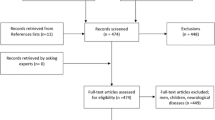Abstract
Introduction and hypothesis
Interruption of urine flow during micturition has been used as an assessment of ability to voluntarily contract the pelvic floor muscles (PFM). However, the PFM are also activated during specific abdominal manoeuvres. This study aimed to assess the effect of similar abdominal manoeuvres on urine flow and compare this with the effect of PFM contraction.
Methods
Eight healthy women, of mixed parity, contracted the abdominal muscles and the PFM during urine flow on separate occasions. Differences in urine flow were compared using paired t tests.
Results
All participants were able to interrupt the urine stream using both muscle activation patterns. There was no difference in the time taken to interrupt urine flow (p = 0.78) between the two patterns.
Conclusions
These data provide evidence that specific abdominal muscle manoeuvres influence urethral closure in continent women, and this is probably mediated by concurrent activation of PFM during the abdominal task.

Similar content being viewed by others
References
Abrams P, Cardozo L, Fall M, Griffiths D, Rosier P, Ulmsten U et al (2002) The standardization of terminology of lower urinary tract function; report from the standardization sub-committee of the International Continence Society. Neurourol Urodyn 21:167–178
Sampselle C, DeLancey JOL (1992) The urine stream interruption test and pelvic muscle function. Nurs Res 41:73–77
Sapsford RR, Hodges PW (2001) Contraction of the pelvic floor muscles during abdominal maneuvers. Arch Phys Med Rehabil 82:1081–1088
Bo K, Sherburn M, Allen T (2003) Trans-abdominal ultrasound measurement of pelvic floor muscle activity when activated directly or via transversus abdominis muscle contraction. Neurourol Urodyn 322:582–588
Neumann P, Gill V (2002) Pelvic floor and abdominal muscle interaction: EMG activity and intra-abdominal pressure. Int Urogynecol J 13:125–132
Urquhart DM, Hodges PW, Allen TJ, Story IH (2005) Abdominal muscle recruitment during a range of voluntary exercises. Man Ther 10:144–153
Sapsford RR, Markwell SJ, Clarke B (1998) The relationship between urethral pressure and abdominal muscle activity. Proceedings of the International Continence Society Conference, Jerusalem, abstract 262
Vanderhorst VG, Terasawa E, Ralston HJ, Holstege G (2000) Monosynaptic projections from nucleus retroambiguous to motoneurons supplying the abdominal wall, axial, hind limb and pelvic floor muscles in the female rhesus monkey. J Comp Neurol 424:233–250
Vanderhorst VG, Holstege G (1997) Nucleus retroambiguus projections to lumbosacral motoneuronal cell groups in the male cat. J Comp Neurol 382:77–88
Amarenco G, Ismail SS, Lagauche D, Raibaut P, Rene-Corail P, Wolff N, Thoumie P, Haab F (2005) Cough anal reflex: strict relationship between intravesical pressure and pelvic floor muscle electromyographic activity during cough. J Urol 173:149–152
Hodges PW, Sapsford R, Pengel LHM (2007) Postural and respiratory functions of the pelvic floor muscles. Neurourol Urodyn 26:362–371
Yamamoto S, Araki K, Kikuchi M (1961) Abdominal muscle reflexes of pelvic nerve origin in cats. Exp Neurol 4:345–357
Sapsford RR, Hodges PW, Richardson CA, Cooper DH, Markwell SJ, Jull GA (2001) Co-activation of the abdominal and pelvic floor muscles during voluntary exercises. Neurourol Urodyn 20:31–42
Richardson CA, Jull GA, Hodges PW, Hides JA (1999) Therapeutic exercise for spinal segmental stabilisation in low back pain: scientific basis and clinical approach. Churchill Livingstone, Edinburgh
Hides JA, Richardson CA, Jull GA (1998) Use of real-time ultrasound imaging for feedback in rehabilitation. Man Ther 3:125–131
Mantle J (2004) Urinary function and dysfunction. In: Mantle J, Haslam J, Barton S (eds) Physiotherapy in obstetrics and gynaecology, 2nd edn. Butterworth Heinemann, Edinburgh, pp 333–382
Sampselle CM (1993) Using a stopwatch to assess pelvic muscle strength in the urine stream interruption test. Nurse Pract 18:14–18
Junginger B, Baessler K, Sapsford R, Hodges P (2010) Effect of abdominal and pelvic floor tasks on muscle activity, abdominal pressure and bladder neck. Int Urogynecol J Pelvic Floor Dysfunct 21:69–77
Satore A, Pregazzi R, Bortoli P, Grimaldi E, Ricci G, Guaschino S (2002) The urine interruption test and female pelvic muscle function in the puerperium. Int J Gynecol Obstet 78:235–239
Bo K, Stien R (1994) Needle EMG registration of striated urethral wall and pelvic floor muscle activity patterns during cough, valsalva, abdominal, hip adductor and gluteal muscle contractions in nulliparous healthy females. Neurourol Urodyn 13:35–41
Bo K, Braekken IH, Majida M, Engh ME (2009) Constriction of the levator hiatus during instruction of pelvic floor or transversus abdominis contraction: a 4D ultrasound study. Int Urogynecol J Pelvic Floor Dysfunct 20:27–32
Blok B, Willemsen ATM, Holstege G (1997) A PET study on brain control of micturition in humans. Brain 120:111–121
Roenen J, De Laet K, De Wachter S, Wyndaele J (2005) Does the urine stream interruption test cause dysfunctional voiding? Proceedings of the International Continence Society Conference, Montreal, Abstract 335
Blok B, Groen J, Veltman D, Bosch R, Lammertsma A (2003) Brain plasticity and urge incontinence: PET studies during the first hours of neuromodulation. Neurourol Urodyn 22:490–491
Wennergren HM, Ogerg BE, Sandstedt P (1991) The importance of leg support for relaxation of the pelvic floor muscles. Scand J Urol Nephrol 25:205–221
Acknowledgements
We thank Susannah Kelley for the ultrasound monitoring of the abdominal muscles and Sue Markwell for assistance with data collection. R Sapsford received funding from the Dorothy Hopkins Award for Clinical Study from the Queensland Branch of the Australian Physiotherapy Association. P Hodges is supported by a Senior Principal Research Fellowship from the National Health and Medical Research Council of Australia.
Conflicts of interest
None.
Author information
Authors and Affiliations
Corresponding author
Rights and permissions
About this article
Cite this article
Sapsford, R.R., Hodges, P.W. The effect of abdominal and pelvic floor muscle activation on urine flow in women. Int Urogynecol J 23, 1225–1230 (2012). https://doi.org/10.1007/s00192-011-1654-2
Received:
Accepted:
Published:
Issue Date:
DOI: https://doi.org/10.1007/s00192-011-1654-2




